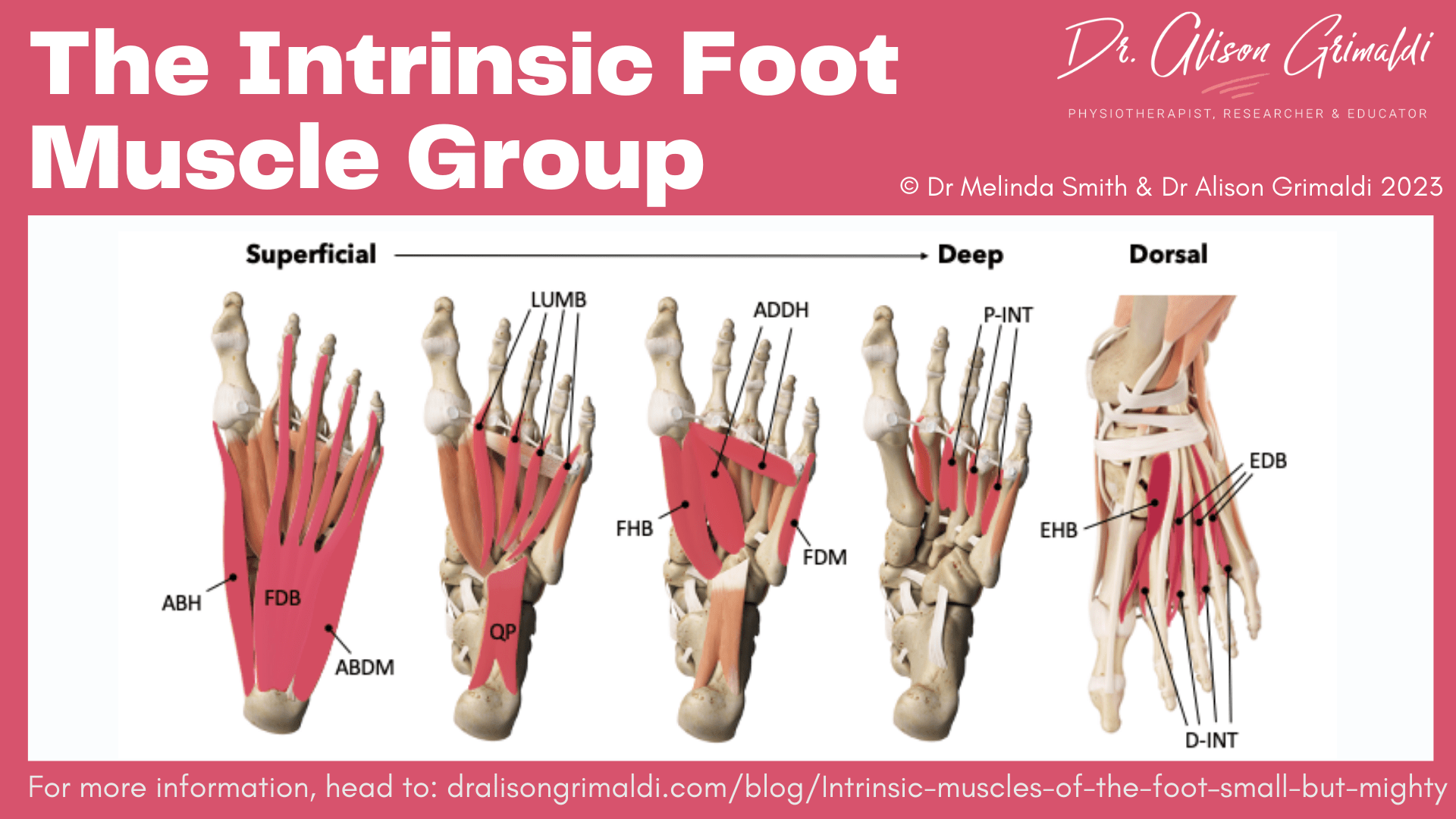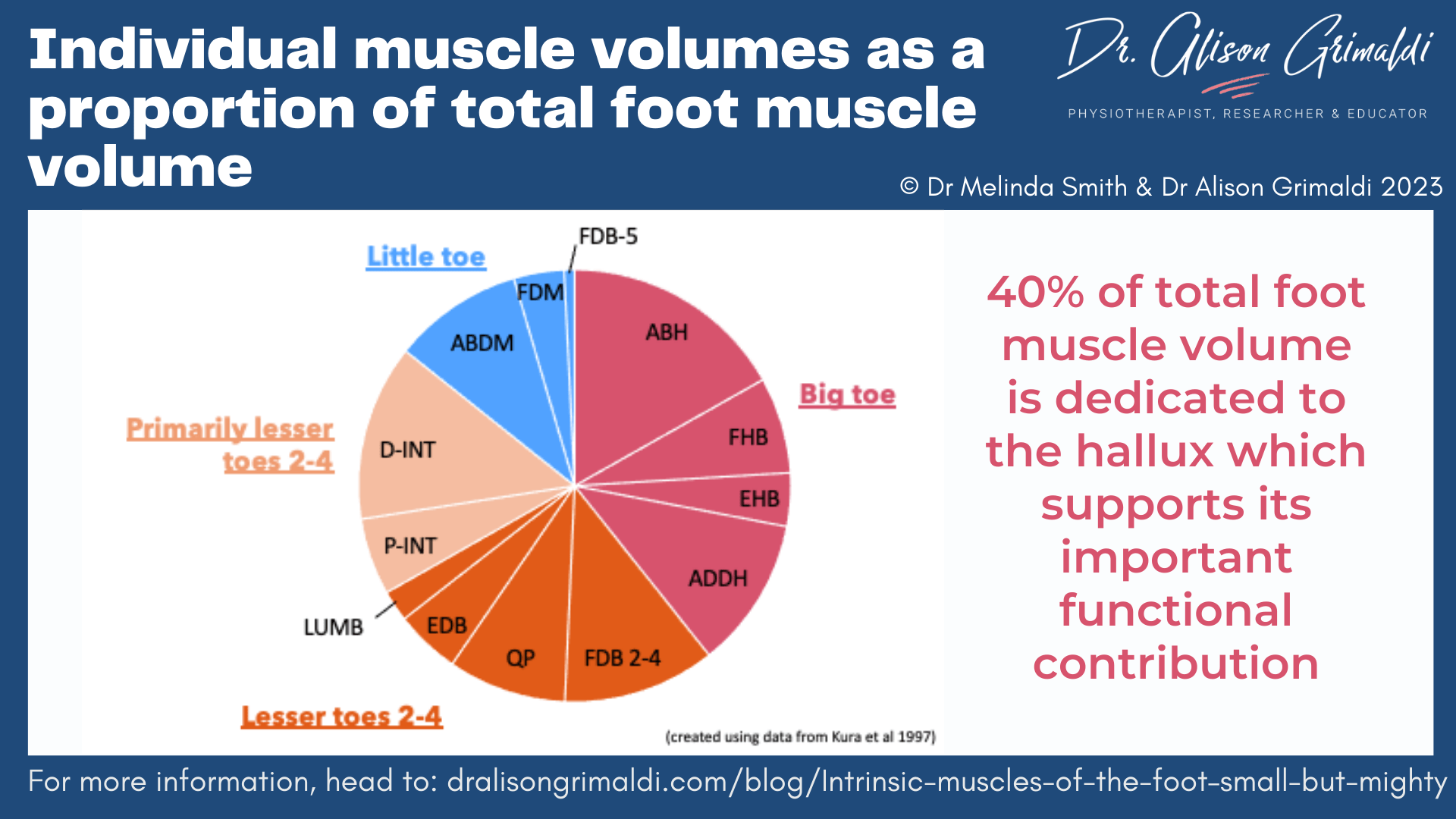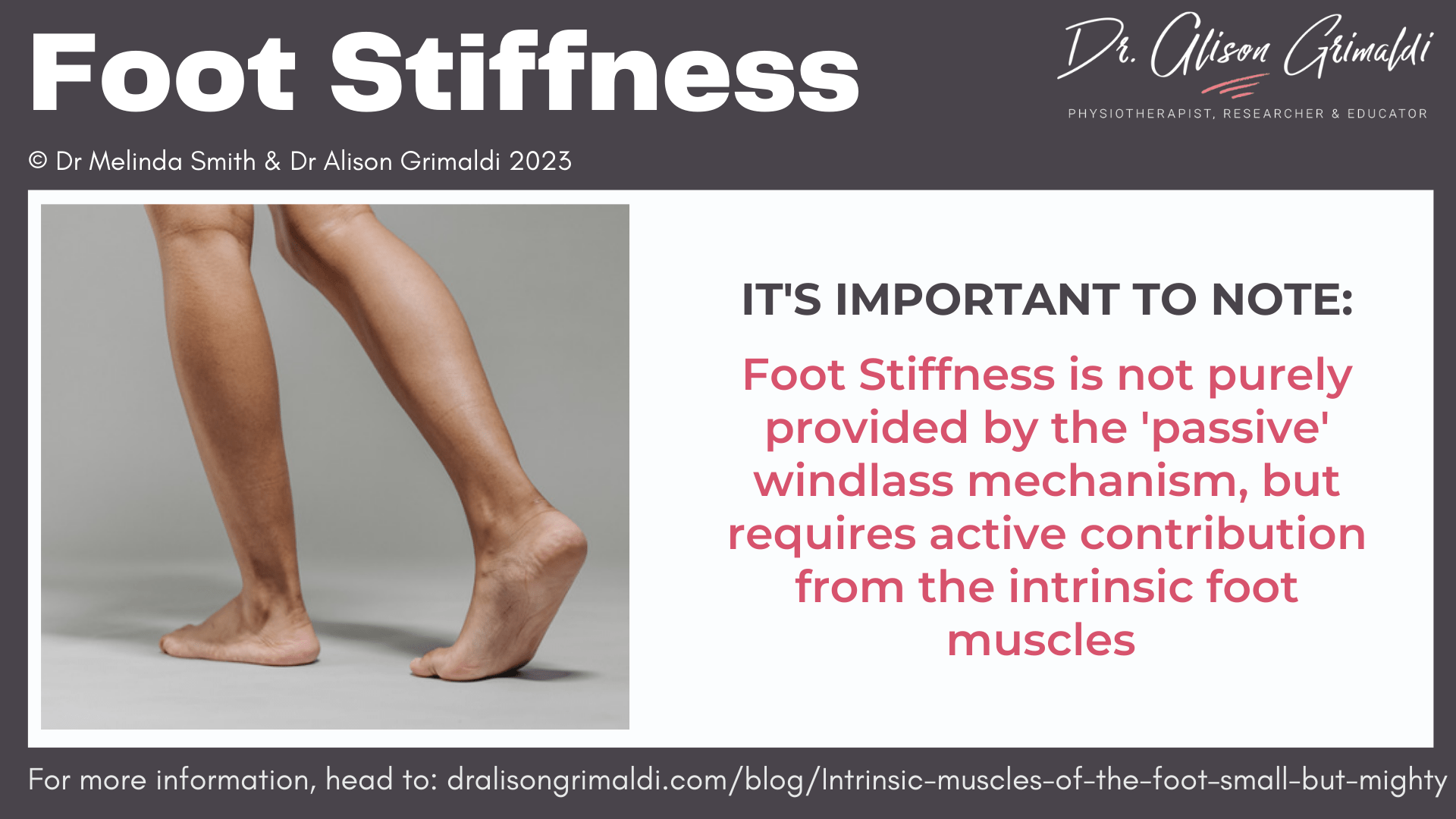Intrinsic muscles of the foot – small but mighty!

When managing clients with a foot or ankle condition, do you consider all the important mechanisms and muscles that provide stability and optimal function? Or are those intrinsic muscles of the foot all a little overwhelming?
It’s understandable! The foot is a complex structure – for example there are twenty muscles that reside in the foot – not to mention the tendons of many extrinsic muscles that course a pathway to their insertion and contribute to foot and ankle function. But thanks to the advances of modern science and biomechanical technology, we now have more information about intrinsic foot muscle function than ever before. The evidence suggests that these muscles may be small, but their contribution to foot and ankle function is mighty!
Let’s take a closer look at their contribution to foot and ankle function and why these small but mighty muscles should be considered in your clinical practice.
Here’s what we’re going to explore:
Discover our brand new Foot and Ankle Course
Intrinsic foot muscle structure and implications for function
A group of muscles that reside in the foot
The intrinsic foot muscles are a group of muscles that reside within the foot. Both anatomical attachments (origin and insertion) of these muscles are in the foot. This is a key distinguishing feature from the extrinsic muscles that have their origin in the leg and long tendons that course the ankle to insert at the foot.
The intrinsic foot muscles include:
- Abductor hallucis (ABH)
- Flexor digitorum brevis (FDB)
- Quadratus plantae (QP)
- Abductor digiti minimi (ABDM)
- Flexor hallucis brevis (FHB)
- Adductor hallucis (ADDH)
- Lumbricals (LUMB)
- Dorsal interossei (D-INT)
- Plantar interossei (P-INT)
- Flexor digiti minimi (FDM)
- Extensor digitorum brevis (EDB)
- Extensor hallucis brevis (EHB)

The intrinsic foot muscles are primarily located on the plantar aspect of the foot – with exception of the extensor digitorum brevis, extensor hallucis brevis and the dorsal interossei (although the latter are often considered part of the deep layer as they reside between the metatarsals). Majority of these muscles course a pathway parallel to the long axis of the foot and are anatomically configured to generate torque about the longitudinal arches.
Intrinsic foot muscle morphology
The size of the intrinsic foot muscles (and therefore force potential) varies considerably from the abductor hallucis which is typically the largest (cross-sectional area 7cm2; volume 15cm3) to the lumbricals which are typically the smallest (cross-sectional area <0.25cm2; volume <1cm3).1 As illustrated in the figure below, approximately 40% of total foot muscle volume is dedicated to the hallux which supports the important functional contribution of the first ray and medial longitudinal arch to foot function. It is worth noting that although some muscles, such as the individual dorsal and plantar interossei, are considered small (cross-sectional area <3cm2), when we consider their volume as a group, they comprise a substantial proportion (~20%) of overall foot muscle volume (and therefore substantial contribution to force production).

Intrinsic foot muscle architecture
The majority of intrinsic foot muscles are unipennate or bipennate suggesting that the function of these muscles is not specific to high force production (as seen in multipennate muscles) nor high excursion (as seen in parallel muscles).2,3Pennation angles are generally small - even the abductor digiti minimi muscle which has the largest pennation angle (19.1°) applies 95% of its force in the direction of the tendon axis.2 The fiber length to muscle length ratio is low for most intrinsic foot muscles, expressing a design bias toward force production rather than excursion.1 This probably makes sense if we think of foot function – we don’t see the large ranges of motion at the foot as compared to the ankle. This supports their description of more of a stabilising/stiffening role, shock absorber and provider of proprioceptive information.4
Multi-segmentation provides the ability to generate a variety of force vectors
Anatomical studies have described multi-segmentation within the individual intrinsic foot muscles, with each muscle containing at least three distinctly variable segments.3 This suggests the ability of the central nervous system to generate a range of force vectors. The advantage of such as system is the ability to fine-tune movements via targeted contractions of specific muscle segments and generate unique differentiated lines of force. This design feature makes sense when we think of the extremely varied demands on foot function.
High muscle spindle density suggests a sensory role
Muscle spindles are considered an important source of proprioception.5 The stimulus for a muscle spindle is muscle length, that is, stretch or lengthening of the receptor. Muscle spindles are scattered throughout skeletal muscles and the number present in any given muscle is not related solely to muscle size. The figure below demonstrates the high density of muscle spindles in the intrinsic foot muscles.6 In fact, the intrinsic foot muscles have significantly higher density of muscle spindles than the extrinsic muscles and are comparable to the small muscles of the hand!

Function of these muscles then may be integral to the neuromotor aspect of foot & ankle stability. Indeed, research suggest that afferent input from the intrinsic foot muscles contribute significant information about the displacement of the standing body.7-9 This sensory role also makes sense given their anatomical configuration. They lack mechanical advantage for producing large joint motions, but they are advantageously positioned to provide sensory information (via the stretch response) about changes in the foot dome posture.4
Intrinsic foot muscle structure and implications for function
Both anatomical attachments within the foot
Variable muscle size & therefore force potential
Design bias toward force production (than excursion)
Multi - segmentation allows a variety of force vectors
High muscle spindle density suggests sensory role
Discover our brand new Foot and Ankle Course
If you're enjoying this blog, you might like to take the online course. With 9.5 hours of online learning content, explore the different aspects of foot and ankle function and the implications this has for muscle and movement assessment and therapeutic exercise prescription around the foot and ankle.
Intrinsic foot muscle contributions to lower limb function
Balance
Research studies have reported that intrinsic foot muscle activation and toe flexor strength is correlated to balance performance. Using fine-wire electromyography recordings researchers reported that activity of abductor hallucis, flexor digitorum brevis and quadratus plantae was correlated to mediolateral sway during a single leg balance task.10 Higher recruitment of these muscles during medial shifts of the centre of pressure suggests a function in balance control. Several studies have reported that strength of the toe flexor muscles are important determinants of balance and functional ability in older adults (age 60-90 years).11-13 In one study, 13 data from over 300 adults ages 60-90 years demonstrated that reduced toe flexor strength was associated with an increased risk of falling. For every 1% body weight increase in hallux strength, the odds of sustaining a fall decreased by almost 7%. This may be something that we can address in the clinic.
Systematic reviews report that toe flexor strength contributes to improved postural balance for people over the age of 60 and that older individuals who performed intrinsic foot muscle strengthening had improvements in muscle strength and balance.14,15 Another systematic review that included asymptomatic and symptomatic populations of a variety of ages also reported that intrinsic foot muscle exercise interventions improved balance.16 Some studies reported a reduction in falls incidence despite no changes in strength and this may relate to the proposed sensory role of these muscles – to sense foot position and make postural adjustments.4 This seems to be more relevant for the older adult as another systematic review that synthesised studies primarily in healthy younger adults concluded that there was very low certainty evidence for a favourable effect of interventions anticipated to improve intrinsic foot muscle strength on dynamic balance control.17
Stiffen forefoot for propulsion
Walking and running
Historically, the plantar fascia is considered fundamental to two mechanisms believed integral to the human foot’s role in bipedal walking and running - the windlass mechanism and the arch-spring mechanism.18,19 Recent biomechanical studies have provided new insight, suggesting that active contribution from the intrinsic foot muscles is also important.20,21
Researchers examined walking and running mechanics in nine asymptomatic individuals with and without a tibial nerve block.20 The tibial nerve block was administered to prevent intrinsic foot muscle contraction. With the tibial nerve block, metatarsophalangeal joint stiffness was reduced and there was less positive power produced by the foot and ankle in late stance (i.e. push-off). While work performed by the foot and ankle was reduced with the nerve block, increased work was performed at the hip. Based on these results the researchers suggested that intrinsic foot muscle activation is required to sufficiently stiffen the forefoot to provide a rigid lever against the ground for push-off. In a follow-up study,21 the same researchers reported that plantar fascia strain (via the windlass mechanism) could not explain the stiffening of the foot that was observed with increased push-off effort and foot-ground contact forces, and that electromyographic recordings suggest that intrinsic foot muscles were also contributing to tension developed across the foot.

Jumping
Like their critical role to stiffen the metatarsophalangeal joint at push-off during walking and running, researchers have demonstrated that intrinsic foot muscle activation also affects ankle joint mechanics during jumping by actively regulating the leverage of the foot during the propulsion phase of vertical jumping.22 Other studies have reported that toe flexor strength and intrinsic foot muscle size is related to jump performance including jump height/distance and reactivity (the ability to jump higher with minimal contact time) during repetitive rebound jumping in adults and children.23-26 Intrinsic foot muscle training, particularly toe flexor exercise, may be a potential target for individuals engaging in running and jumping based activities or sports. There is however currently limited evidence to guide this with further high quality randomized trials needed.27
Modulate energy absorption and generation at the foot
Biomechanical studies demonstrate that across various tasks including walking, running, jumping and landing, the intrinsic foot muscles contribute to energy absorption and generation at the foot.28-33 Their key distinguishing feature, when compared to other structures such as the plantar fascia and plantar fat pads, is that they can actively modify the energetic capacity of the foot to respond to varying demands on foot function. Investigation of muscle-tendon dynamics of the flexor digitorum brevis during stepping, jumping and landing showed that energy was stored in the tendinous tissue during arch compression and during arch recoil muscle fascicles shortened at a slower rate than the tendinous tissue even though the foot was generating energy.33 The researchers suggested that the central nervous system can use arch compression and elastic energy storage in the tendinous tissues of the intrinsic muscles to add or remove energy as required. With increasing running speed, the foot is required to dissipate a greater proportion of absorbed energy as loading rates increases.31 It is plausible that impaired intrinsic foot muscle contribution may have implication for load on other structures such as the plantar fascia, plantar fat pads and bones of the foot.
Landing requires the attenuation of impact forces as well as stabilisation. Flexor hallucis brevis cross-sectional area has been shown to correlate to force attenuation in a single-leg drop landing in asymptomatic adults.24 Larger size of the flexor hallucis brevis muscle was associated with lower peak vertical ground reaction forces. This supports previous biomechanical studies that suggest the intrinsic foot muscles assist force attenuation. In another small biomechanical study, instructing individuals to flex at the metatarsophalangeal joint (toe push toward the ground) at the moment of landing from a single-leg step down task resulted in lower ground reaction forces.34 These findings may have implication for individuals with a history of bone related injuries, however this has not been examined in the scientific literature.
Modulate tension on passive structures such as the plantar fascia
There are close anatomical relationships between the intrinsic foot muscles and the plantar fascia. The plantar fascia, flexor digitorum brevis, abductor hallucis and abductor digiti minimi all share attachment at the calcaneal tuberosity.35Anatomical dissections report the plantar fascia is firmly attached to the superficial intrinsic foot muscles, particularly at this proximal insertion.36 Muscle fibers of the abductor hallucis and abductor digiti minimi insert to the medial and lateral portions of the plantar fascia, respectively. Distally, some perpendicular septae envelope the abductor hallucis and the four tendons of the flexor digitorum brevis.36
Feasibly, contraction of these muscles that generate tension along the long axis of the foot in a similar direction as the plantar fascia may potentially assist in reducing load through the plantar facia. In support of this hypothesis a biomechanical study demonstrated that activation of the intrinsic foot muscles abductor hallucis and flexor digitorum brevis can alter MTPj moments to adjust MTPj mechanics and limit strain of the plantar aponeurosis.21 This may have implications for clinical populations such as individuals with plantar heel pain (where the plantar fascia is a commonly involved structure). Taken together with evidence of smaller and weaker intrinsic foot muscles in individuals with plantar heel pain,37 the intrinsic foot muscles may be an important clinical target in assessment and treatment of plantar heel pain.
Intrinsic foot muscle contribution to lower limb function

Balance

Forefoot stiffness for propulsion

Energy absorption and generation at the foot

Modulate tension on passive structures
When should health professionals consider intrinsic foot muscles?
The scientific literature reports deficits in intrinsic foot muscle morphology and/or toe flexor strength in several populations that we might encounter in the clinical setting including:
- Plantar heel pain37
- Hallux valgus38
- Older adults39
- Foot osteoarthritis40
- Exercise related leg pain41,42
- Chronic ankle instability43
- Diabetes44
The running athlete is another population of interest. A randomized controlled trial demonstrated that runners who undertook a foot strengthening program had a lower risk of running related injuries compared to those who did not.45
Most of the studies from these populations have been cross-sectional design – meaning that we cannot discern if intrinsic foot muscle dysfunction is a cause and/or consequence of these pain presentations / conditions. With consideration of the key contribution that the intrinsic foot muscles make to lower limb function, regardless of causation, these small but mighty muscles are an important clinical target.
We hope you’ve found this blog on the structure and function of the intrinsic foot muscles helpful.
Discover our brand new Foot and Ankle Course
If you enjoyed this blog, you might like to take the online course. With 9.5 hours of online learning content, explore the different aspects of foot and ankle function and the implications this has for muscle and movement assessment and therapeutic exercise prescription around the foot and ankle.
References
- Kura H, Luo ZP, Kitaoka HB, An KN. Quantitative analysis of the intrinsic muscles of the foot. The Anatomical Record. 1997;249(1):143-151.
- Ledoux WR, Hirsch BE, Church T, Caunin M. Pennation angles of the intrinsic muscles of the foot. Journal of Biomechanics. 2001;34(3):399-403.
- Tosovic D, Ghebremedhin E, Glen C, Gorelick M, Mark Brown J. The architecture and contraction time of intrinsic foot muscles. Journal Of Electromyography And Kinesiology: Official Journal Of The International Society Of Electrophysiological Kinesiology. 2012;22(6):930-938.
- McKeon PO, Hertel J, Bramble D, Davis I. The foot core system: a new paradigm for understanding intrinsic foot muscle function. British Journal Of Sports Medicine. 2015;49(5):290-290.
- Röijezon U, Clark NC, Treleaven J. Proprioception in musculoskeletal rehabilitation. Part 1: Basic science and principles of assessment and clinical interventions. Manual therapy. 2015;20(3):368-377.
- Peck D, Buxton DF, Nitz A. A comparison of spindle concentrations in large and small muscles acting in parallel combinations. J Morphol. 1984;180(3):243-252.
- Felicetti G, Thoumie P, Do MC, Schieppati M. Cutaneous and muscular afferents from the foot and sensory fusion processing: Physiology and pathology in neuropathies. J Peripher Nerv Syst. 2021;26(1):17-34.
- Knellwolf TP, Burton AR, Hammam E, Macefield VG. Firing properties of muscle spindles supplying the intrinsic foot muscles of humans in unloaded and freestanding conditions. J Neurophysiol. 2019;121(1):74-84.
- Viseux FJF. The sensory role of the sole of the foot: Review and update on clinical perspectives. Neurophysiologie clinique = Clinical neurophysiology. 2020.
- Kelly LA, Kuitunen S, Racinais S, Cresswell AG. Recruitment of the plantar intrinsic foot muscles with increasing postural demand. Clinical Biomechanics (Bristol, Avon). 2012;27(1):46-51.
- Menz HB, Morris ME, Lord SR. Foot and ankle characteristics associated with impaired balance and functional ability in older people. The Journals Of Gerontology Series A, Biological Sciences And Medical Sciences. 2005;60(12):1546-1552.
- Spink MJ, Fotoohabadi MR, Wee E, Hill KD, Lord SR, Menz HB. Foot and ankle strength, range of motion, posture, and deformity are associated with balance and functional ability in older adults. Archives of physical medicine and rehabilitation. 2011;92(1):68-75.
- Mickle KJ, Munro BJ, Lord SR, Menz HB, Steele JR. ISB Clinical Biomechanics Award 2009: toe weakness and deformity increase the risk of falls in older people. Clin Biomech (Bristol, Avon). 2009;24(10):787-791.
- Quinlan S, Fong Yan A, Sinclair P, Hunt A. The evidence for improving balance by strengthening the toe flexor muscles: A systematic review. Gait & posture. 2020;81:56-66.
- Futrell EE, Roberts D, Toole E. The effects of intrinsic foot muscle strengthening on functional mobility in older adults: A systematic review. J Am Geriatr Soc. 2021.
- Jaffri A, Koldenhoven R, Saliba S, Hertel J. Evidence of Intrinsic Foot Muscle Training in Improving Foot Function: A Systematic Review and Meta-analysis. J Athl Train. 2022.
- Willemse L, Wouters EJM, Bronts HM, Pisters MF, Vanwanseele B. The effect of interventions anticipated to improve plantar intrinsic foot muscle strength on fall-related dynamic function in adults: a systematic review. Journal of foot and ankle research. 2022;15(1):3.
- Hicks JH. The mechanics of the foot. II. The plantar aponeurosis and the arch. J Anat. 1954;88(1):25-30.
- Ker RF, Bennett MB, Bibby SR, Kester RC, Alexander RM. The spring in the arch of the human foot. Nature. 1987;325(7000):147-149.
- Farris DJ, Kelly LA, Cresswell AG, Lichtwark GA. The functional importance of human foot muscles for bipedal locomotion. Proceedings of the National Academy of Sciences of the United States of America. 2019;116(5):1645-1650.
- Farris DJ, Birch J, Kelly L. Foot stiffening during the push-off phase of human walking is linked to active muscle contraction, and not the windlass mechanism. Journal of the Royal Society, Interface. 2020;17(168):20200208.
- Smith R, Lichtwark G, Farris D, Kelly L. Examining the intrinsic foot muscles' capacity to modulate plantar flexor gearing and ankle joint contributions to propulsion in vertical jumping. Journal of sport and health science. 2022.
- Yamauchi J, Koyama K. Importance of toe flexor strength in vertical jump performance. J Biomech. 2020;104:109719.
- Morikawa M, Maeda N, Komiya M, et al. Contribution of Plantar Fascia and Intrinsic Foot Muscles in a Single-Leg Drop Landing and Repetitive Rebound Jumps: An Ultrasound-Based Study. International journal of environmental research and public health. 2021;18(9).
- Morita N, Yamauchi J, Kurihara T, et al. Toe Flexor Strength and Foot Arch Height in Children. Med Sci Sports Exerc. 2015;47(2):350-356.
- Arima S, Maeda N, Tsutsumi S, et al. Association of the intrinsic foot muscles and plantar fascia with repetitive rebound jumping and jump landing in adolescent athletes: An ultrasound-based study. Gait Posture. 2023;99:146-151.
- Goldmann J-P, Sanno M, Willwacher S, Heinrich K, Brüggemann G-P. The potential of toe flexor muscles to enhance performance. Journal of sports sciences. 2013;31(4):424-433.
- Riddick R, Farris DJ, Kelly LA. The foot is more than a spring: human foot muscles perform work to adapt to the energetic requirements of locomotion. J R Soc Interface. 2019;16(150):20180680.
- Smith RE, Lichtwark GA, Kelly LA. The energetic function of the human foot and its muscles during accelerations and decelerations. J Exp Biol. 2021;224(13).
- Kelly LA, Farris DJ, Cresswell AG, Lichtwark GA. Intrinsic foot muscles contribute to elastic energy storage and return in the human foot. Journal of Applied Physiology. 2019;126:231-238.
- Kelly LA, Cresswell AG, Farris DJ. The energetic behaviour of the human foot across a range of running speeds. Sci Rep-Uk. 2018;8:10576.
- Kelly LA, Lichtwark G, Cresswell AG. Active regulation of longitudinal arch compression and recoil during walking and running. Journal Of The Royal Society, Interface / The Royal Society. 2015;12(102):20141076-20141076.
- Smith RE, Lichtwark GA, Kelly LA. Flexor digitorum brevis utilizes elastic strain energy to contribute to both work generation and energy absorption at the foot. J Exp Biol. 2022;225(8).
- Oku K, Kimura D, Ito T, et al. Effect of Increased Flexor Hallucis Longus Muscle Activity on Ground Reaction Force during Landing. Life (Basel, Switzerland). 2021;11(7).
- Kelikian AS, Sarrafian SK. Sarrafian's anatomy of the foot and ankle : descriptive, topographical, functional. 3rd ed. ed. Philadelphia: Wolters Kluwer Health/Lippincott Williams & Wilkins; 2011.
- Stecco C, Corradin M, Macchi V, et al. Plantar fascia anatomy and its relationship with A chilles tendon and paratenon. Journal of Anatomy. 2013;223(6):665-676.
- Osborne JWA, Menz HB, Whittaker GA, Landorf KB. Muscle Function and Muscle Size Differences in People With and Without Plantar Heel Pain: A Systematic Review. J Orthop Sports Phys Ther. 2019;49(12):925-933.
- Moulodi N, Azadinia F, Ebrahimi-Takamjani I, Atlasi R, Jalali M, Kamali M. The functional capacity and morphological characteristics of the intrinsic foot muscles in subjects with Hallux Valgus deformity: A systematic review. Foot (Edinburgh, Scotland). 2020;45:101706.
- Mickle KJ, Angin S, Crofts G, Nester CJ. Effects of Age on Strength and Morphology of Toe Flexor Muscles. The Journal Of Orthopaedic And Sports Physical Therapy. 2016;46(12):1065-1070.
- Arnold JB, Halstead J, Grainger AJ, Keenan AM, Hill CL, Redmond Anthony C. Foot and Leg Muscle Weakness in People With Midfoot Osteoarthritis. Arthritis Care Res (Hoboken). 2021;73(6):772-780.
- Nedimyer AK, Pietrosimone BG, Luc-Harkey BA, Wikstrom EA. Intrinsic Foot Muscle Morphology in Active Runners With and Without a History of Exercise-Related Lower Leg Pain. International journal of athletic therapy & training. 2020;25(2):62-67.
- Garth WP, Jr., Miller ST. Evaluation of claw toe deformity, weakness of the foot intrinsics, and posteromedial shin pain. The American Journal Of Sports Medicine. 1989;17(6):821-827.
- Feger MA, Snell S, Handsfield GG, et al. Diminished Foot and Ankle Muscle Volumes in Young Adults With Chronic Ankle Instability. Orthopaedic journal of sports medicine. 2016;4(6):2325967116653719-2325967116653719.
- Thukral N, Kaur J, Malik M. A systematic review on foot muscle atrophy in patients with diabetes mellitus. International journal of diabetes in developing countries. 2023;43(3):331-337.
- Taddei UT, Matias AB, Duarte M, Sacco ICN. Foot Core Training to Prevent Running-Related Injuries: A Survival Analysis of a Single-Blind, Randomized Controlled Trial. Am J Sports Med. 2020;48(14):3610-3619.

